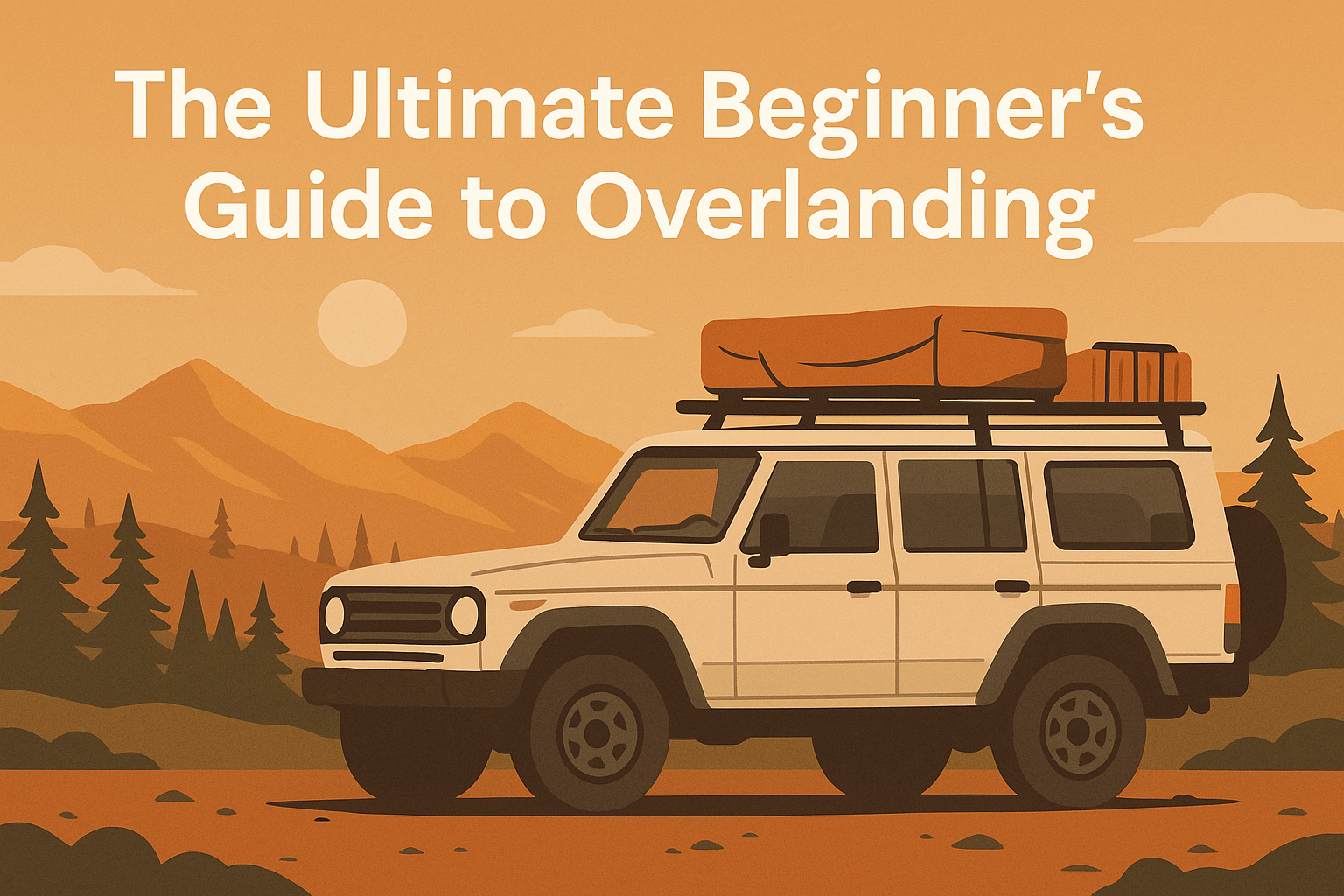Everything You Need to Know Before Your First Trip
Overlanding is more than just camping or off-roading—it’s about self-reliance, exploration, and discovering remote places using your vehicle as both transportation and home. Whether you’re dreaming of crossing deserts, exploring mountain trails, or simply spending weekends unplugged from daily life, this guide will walk you through everything you need to know to get started in 2025.
🚙 What Is Overlanding?
Overlanding is long-distance vehicle travel to remote areas where the journey itself is the goal. You travel with everything you need to survive—food, water, shelter, and tools—typically camping in the wild and staying off-grid for extended periods. Unlike vanlife, which often revolves around comfort and lifestyle on paved roads, overlanding is focused on exploration, rugged terrain, and self-sufficiency.
Many people think you need an expensive modified 4×4 vehicle to go overlanding, but the true spirit of overlanding is not about luxury gear or extreme builds—it’s about independence, adaptability, and an adventurous mindset.
Key difference from camping: Overlanding is about self-sufficiency and exploration, not just staying in one place.
🌍 Why Overlanding Is Growing in 2025
Overlanding has exploded in popularity due to:
- Rising interest in off-grid travel and outdoor freedom
- Improved vehicle technology and gear accessibility
- Growing communities on YouTube and social media
- A desire to disconnect from digital life and reconnect with nature
🧭 Overlanding vs. Other Styles of Travel
| Travel Style | Main Focus | Duration | Accommodation | Terrain | Independence |
|---|---|---|---|---|---|
| Car Camping | Convenience | 1–3 days | Tent / Car | Light off-road | Low |
| Vanlife | Lifestyle | Weeks–Months | Built camper | Mostly paved | Medium |
| Overlanding | Remote Exploration | Multi-day to multi-month | Vehicle-based | Off-road & off-grid | High |
✅ If you want adventure, challenge, and self-sufficiency—overlanding is the ultimate experience.
🔧 Do You Need a Special Vehicle?
A common misconception is that you need a fully built expedition vehicle to begin overlanding. The truth is, many beginners start with stock SUVs, trucks, or crossovers. The most important features are reliability, ground clearance, and the ability to carry your gear safely. Over time, you can add upgrades such as all-terrain tires, a roof rack, or a basic recovery kit. Start with what you already have, learn the basics, and make improvements as your needs grow.
Minimum Vehicle Requirements:
- Good ground clearance
- Reliable engine & suspension
- All-terrain or off-road capable tires
- Roof rack or space for gear
Optional Upgrades for Longer Trips:
- All-terrain tires
- Recovery points
- Roof storage or rooftop tent
- Dual battery or power station
Start with what you have and upgrade over time.
🎒 Essential Skills for Beginner Overlanders
You don’t need to be a professional off-road driver or survival expert to start. However, overlanding does require a willingness to learn and adapt. Basic navigation skills, such as reading maps and understanding GPS waypoints, are important—especially in areas without cell service. You should also be comfortable performing simple vehicle maintenance, such as checking tire pressure, fluid levels, and changing a tire.
Planning is a critical overlanding skill. Knowing your fuel range, researching legal camping areas, and preparing for sudden weather changes will make your trip safer and more enjoyable. Good overlanders also practice responsible land stewardship by following Leave No Trace principles and respecting wildlife and local regulations.
✅ Basic Navigation
- Learn to navigate using offline maps and GPS
- Understand topographic maps and trail markers
✅ Vehicle Awareness
- Know how to check tire pressure, oil, fluids
- Practice changing a tire on your own
✅ Trip Planning
- Know your fuel range
- Identify legal camping areas
- Always have a backup exit route
✅ Safety & Communication
- Let someone know your travel plan
- Carry first aid supplies and emergency contacts
- Consider a satellite communicator for no-service areas
🏕 What You Need to Start Overlanding
Many marketing campaigns make it seem like you need thousands of dollars’ worth of equipment before you hit the trail. In reality, you only need a few essentials to start:
Must-Have Basics:
- Shelter: ground tent, rooftop tent, or sleeping setup in your vehicle
- Water storage (at least 4–5 gallons)
- Food storage & cooking equipment
- Recovery gear (tow strap, shovel, traction boards)
- Navigation tools (GPS device or offline apps)
Good-to-Have Gear:
- Portable power station
- Solar panel for charging
- Camp lighting
- First aid and emergency kit
👉 The key is self-reliance: you must be able to eat, sleep, navigate, and recover your vehicle without assistance.
How to Plan Your First Overlanding Trip
🔹 Step 1: Choose a Beginner-Friendly Route
Start with national forest roads or BLM land with marked trails.
🔹 Step 2: Check Regulations
Some areas allow dispersed camping, others require permits.
🔹 Step 3: Prepare a Vehicle Loadout
Don’t overload your vehicle. Pack only what you truly need.
🔹 Step 4: Travel with a Purpose
Overlanding isn’t a race—it’s about the journey. Slow down and explore.
Safety Tips for Beginners
- Always check the weather forecast
- Travel with at least half a tank of fuel at all times
- Keep communication devices within reach
- Practice Leave No Trace principles
- Respect wildlife and local regulations
🙌 Joining the Overlanding Community
One of the best parts of overlanding is the community. You’ll find groups on:
- Facebook and Reddit
- YouTube channels
- Overlanding events and expos
- Local meetup groups
These communities are an incredible source of knowledge, support, and trail information.
🧭 Final Thoughts
Overlanding isn’t about having the most expensive gear or the most modified rig—it’s about freedom, connection to nature, and the adventure of the unknown.
👉 Start small. Learn as you go. Upgrade gradually.
Your first trip could be one weekend. It may just change your life.
Ready to take the next step?
Explore our guides on:

